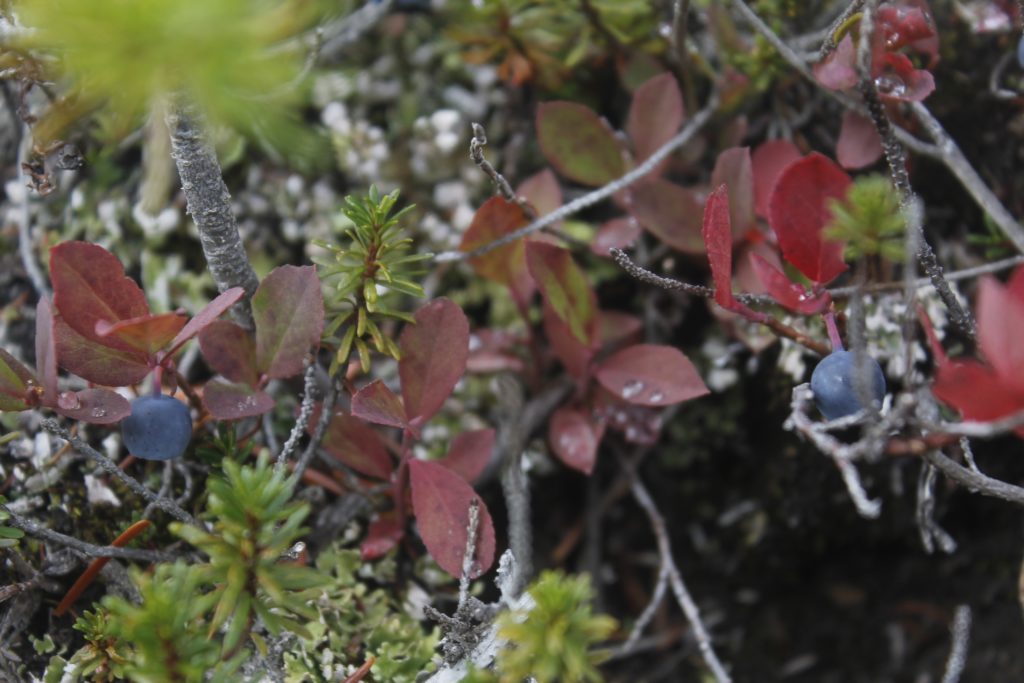
Sol Duc
Deciding where to hike in the Olympic Mountains was no easy task for my friend Sean and I, partly because the area has so many faces.
When we researched the ideal two-night trip, we had our pick of wild beaches along the Pacific Coast, the lush rainforests of the western valleys or amidst the drier, but still massive forests in the rain shadow. Higher trails access alpine tundra, even glacier.
We knew that black bears are a very real presence, to the point that the Park Service require overnight hikers to carry their food in canisters or else use specialized cable hangs available at certain sites. That limits freedom a bit. The park is host to a heavy mountain lion population, which also grabs attention, even if there is only a slightly higher risk of an attack then, say, a Bigfoot sighting.
The more credible threat that I anticipated, was cold September rains, which would throw down the challenge of staying dry — at least warm — while we were hiking and camping.
I wanted us to avoid cold and misery, and enjoy the natural beauty of the Olympics. It would be time for both of us to unplug and recharge.
The trip was also a great chance to catch up with Sean. We go back to college, where we ran cross-country together. He lives in Brooklyn now, but has a passion for getting out, whether to the Catskills or the Adirondacks further north. We’ve done a couple of hikes together through the years, including a couple mountains in the Adirondacks and an icy visit to New Hampshire’s White Mountains this spring.
We chose a path that would show us many of the different zones within the park, including the semi-rain forest of the Sol Duc valley, up to the 5,400-foot Bogachiel Peak, around Seven Lakes Basin, thence down to camp at Hoh Lake and into the Hoh Rain Forest and back the way we came. The plan would get us out of having to carry in a bulky bear canister, because the Hoh Lake campsite had cables where we could hang our food stuff. Even though Seven Lakes is a popular park spot, we had a good shot at enjoying solitude because we would be leaving midweek in September.
I put the tent in my backpack, and gave Sean the pleasure of carrying my cook stove, bulky pots and most of the food.
The sky above the trees was gray as we started along a smooth-packed trail beneath cedar, spruce and fir, their branches draped with the hair-like tendrils of goat’s beard lichen. The Sol Duc River ran through a black walled canyon to our south. Soon, we reached a bridge crossing above Sol Duc Falls, where the river course suddenly turned and dropped into a dark crevice.
Abundant moss grew in the falls mist, further up, spiky stands of devil’s club.
The trail began to climb from here along a series of switchbacks toward Deer Lake.
The cloudy skies had begun to drizzle, then to loose fat drops onto the trees above. Sean and I were protected for the moment, but if the rain continued, the drops would begin rolling off the branches, soaking us.
Neither of us were wearing our rain gear, and we were loath to put it on and start marinating in sweat. Given the mercurial nature of the weather in the northwest, it seemed likely that the rain would pass soon anyway. One day hiker that we passed simply held a trash bag over his head. Not a bad stopgap.
Alas, the rain continued falling, and we started getting wet as we went through clearings. Eventually, we caved and threw on our rain gear and pack covers. That, of course, brought the rain to a prompt halt.
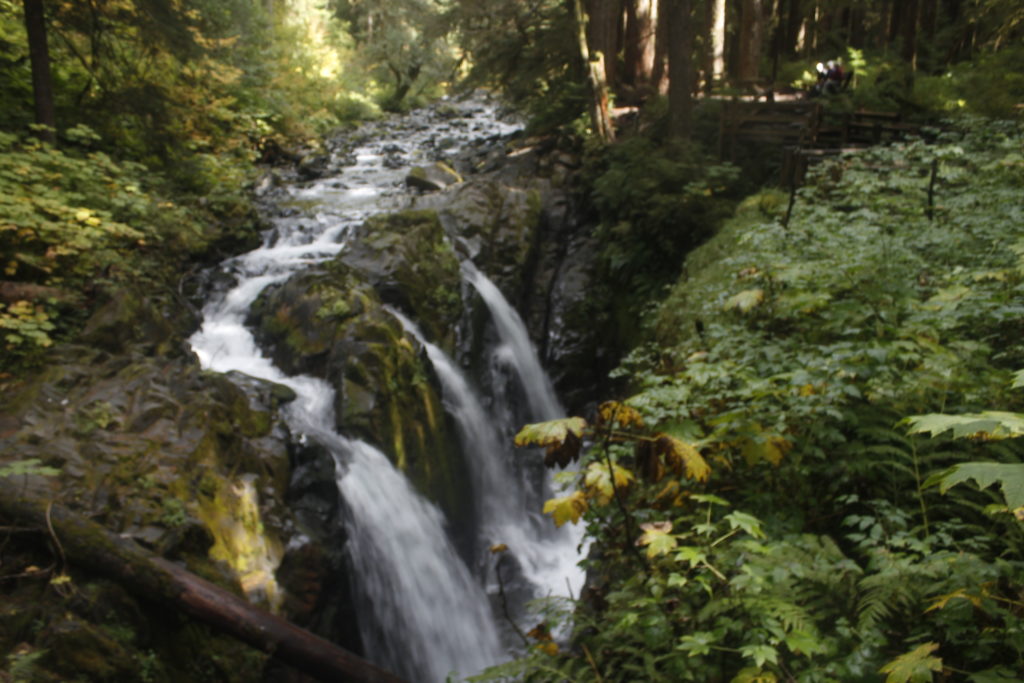
The Bears of Bogachiel
As we climbed above the Sol Duc river, Sean and I hashed out a plan for any encounter with Sasquatch Americanus,.
Say we were going around the bend and Bigfoot walked across the trail, should we tell anyone?
Sean was inclined not to on the basis that anyone we told our story to would think we were lying or nuts. Later we agreed that we would only come forward with a Sasquatch sighting if there we could get solid photographic evidence.
Photographing Bigfoot might have been a tall order, but there were plenty of other opportunities to click the shutter as we climbed past Deer Lake onto an exposed ridge.
The trees became shorter and gnarled. A grand vista opened up to the north where we could see above the foothills across the hard blue water of the Strait of Juan de Fuca out to the mountains on Vancouver Island, British Columbia.
The rocks along the trail were angular, blasted by winter ice. Glacier-carved bowls opened up on either side. Wisps of cloud gathered below.
Further on, we could gaze down into the Seven Lakes Basin, a bare landscape of arctic scrub, sprinkled with water-filled depressions.
“That looks like more than seven lakes,” I remarked.
Sean observed that all of the lakes had fallen from their high-water marks. As the water levels fell, there were places where one lake had diminished into two smaller ones. It had been a dry summer on the Olympic Peninsula. At least we didn’t have to deal with the wildfires and smoke that plagued the park earlier this year.
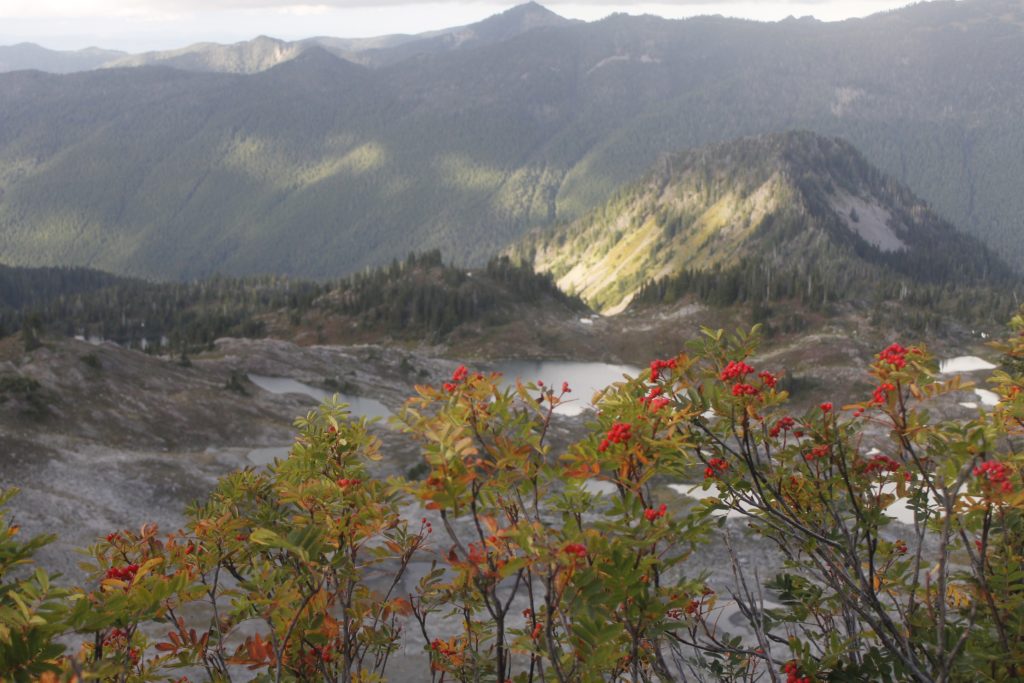
The ridge climbed a saddle where we could look south to the big mountains, including the jagged slopes of Mount Tom and Mount Olympus. Both were hidden in cloud, but occasionally a gap opened where we could peek at a snowfield or glacier.
We had less than a mile to hike down into our camp at Hoh Lake, but the nearby summit of Bogachiel Peak beckoned.
We took a side trail in that direction. The valley below us was filled with low-growing huckleberries with bright red leaves. One dark shape in that field caught my eye. I squinted at it for a moment, sure that it was some shadow cast by a dead tree or boulder. But the shape was moving.
“Hey! That’s a bear down there!”
Most of the bears I’ve seen in the wild have been pretty small, but I’m sure that this one was at least 250 pounds. It grazed slowly among the huckleberries like some bovine in the pasture. If it had noticed us, it didn’t care much.
We watched it for several minutes. Hardly a lumbering brute, the bear moved nimbly among the broken rock, keeping its head down in order to graze microscopic huckleberries out of the twigs and leaves. The black coat had a healthy shine. Elegance isn’t usually the word that pops into mind when I think of bears, but even this large specimen carried itself with refinement and dignity.
Seeing that the bear likely hadn’t noticed us, neither Sean or I bothered to make loud noises or tried to scare it off. We went on along the trail to the top of the mountain.
The lakes and mountains surrounding us delineated a domain of harsh weather and limited resources— a place that played by the old, hard rules that undergird the upholstery of our day-to-day existence.
Soil on these mountain tops stretches thin as erosion constantly feeds it to the valleys below and nothing washes down to replenish it— yet this film of organic matter was enough to support acres of huckleberries and to provide a bounty to the bears.
When Sean and I walked back down the trail, there were two bears grazing. We stared again, and this time, one of them did look up, seeming to acknowledge us. The look wasn’t menacing, but it seemed wise to move on. If nothing else, I didn’t want to disrupt them.
A small blue nugget of bear scat lay in the trail further on. They must have been getting all or most of their calories from the huckleberries, which is impressive considering that the berries growing here were half the size of a pea at largest.
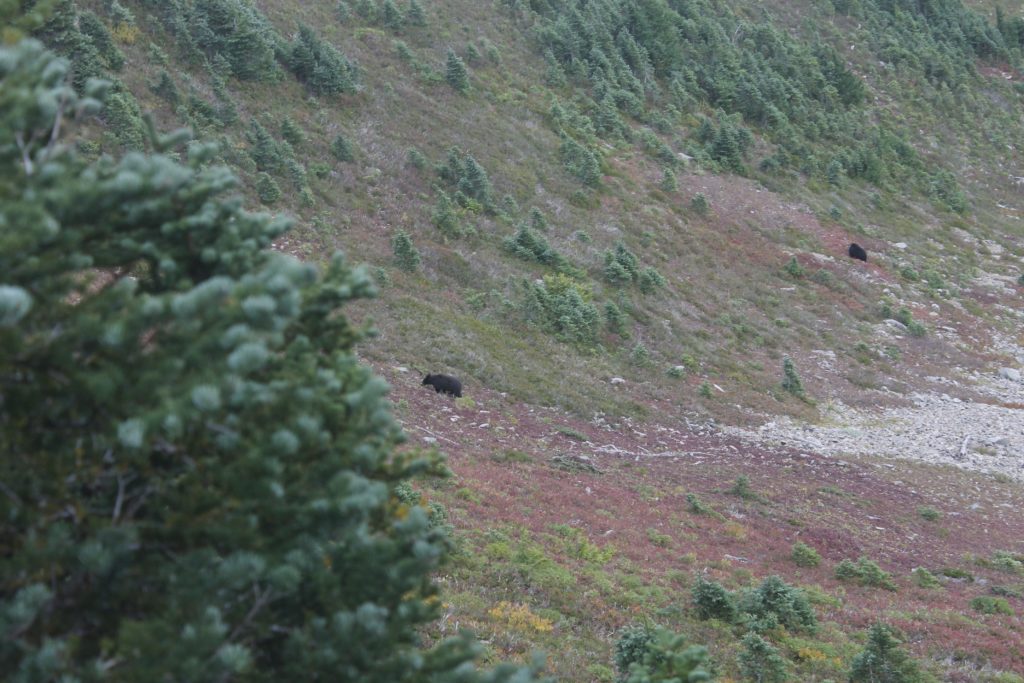
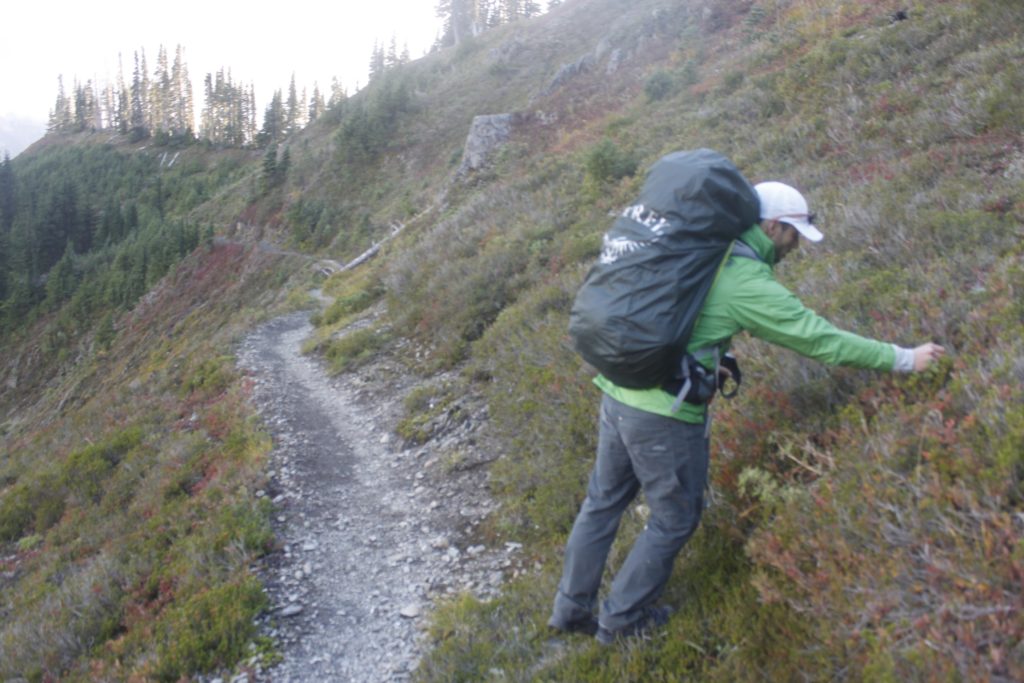
Sean and I picked a few of them as we went. They were tasty, but the picking was incredibly slow. I guessed that the bears would have to pretty much graze continuously at the berries to feed themselves. That was what they appeared to be doing.
The blue splats of bird droppings decorating the rocks along the trail indicated that bears were not the only ones who profited from the berries.
Further down the trail, Sean spotted another bear, also grazing below us. The camp area at Hoh Lake was not too much further. We felt very motivated to be careful with our food, considering that there were bears nearby who were hungry enough to forage for hours in the huckleberries, They could get the calories they needed in minutes from one ambush into our supplies.
Sure enough, Sean saw one bear grazing on the hillside above Hoh lake, only about a quarter mile from where we’d pitched tent.
We turned in early while we still had the warmth of dinner in our bellies. I hoped we would wake up warm and ready to take on whatever the next day had in store.
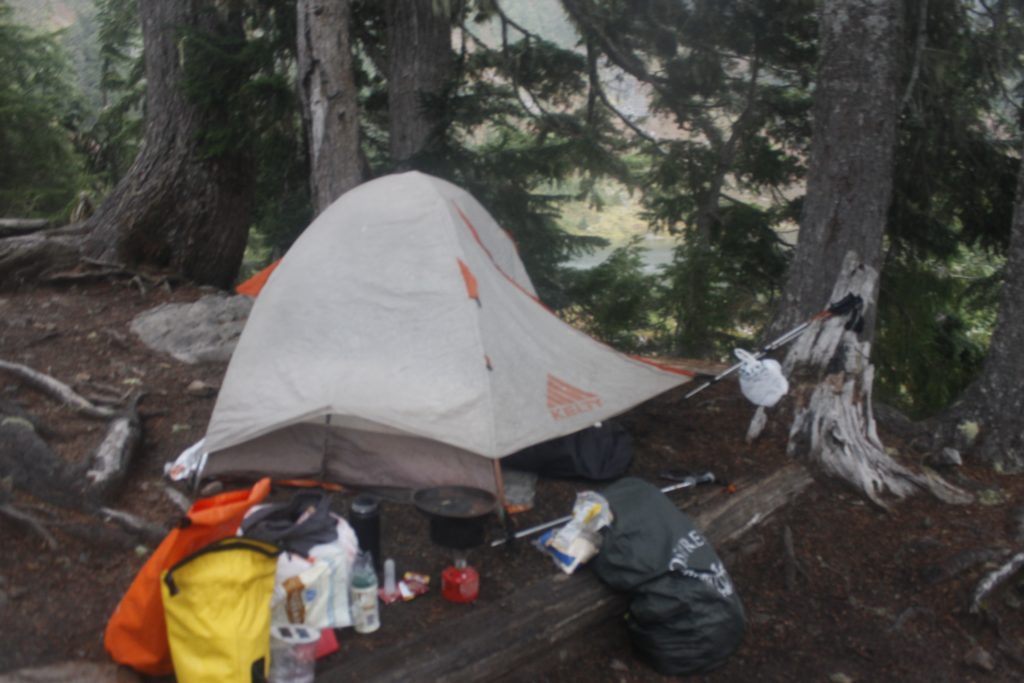
Descent to the Hoh
Cold and mist were in store.
Soon after we awoke, Sean went out to pick some huckleberries to make morning oatmeal more interesting,
We finished our meal by slugging down morning coffee for Sean and some black tea for myself, then we were on the trail to the Hoh rainforest. We left the tent, gear and extra food at at camp (the latter hung up on the bear cable) so that we could move along with lighter loads.
The path dropped past mossy waterfalls, into groves of cedar. Unlike the wide trails we had hiked the day before, this route seemed infrequently traveled, with soaking vegetation closing in on either side of us. Sodden branches bounced harmlessly off of our rain jackets, but my lower half was drenched in short order. One hiker coming up from the other direction wore a makeshift plastic skirt. Excellent idea.
Further down the trail, we found a pile of bones beneath a cedar tree. The massive femurs could have only belonged to an elk. But what had killed it?
Sean speculated that it was a mountain lion. If one of those big cats was about, I definitely wanted my camera at the ready — only now, I discovered that despite my best efforts to protect it, moisture had gotten in and fogged the lens housing.
By the time we met the Hoh River Trail at the bottom of the switchbacks, some six miles below camp, it was already getting later in the day, and it was clear that we would only have a couple of hours to explore.
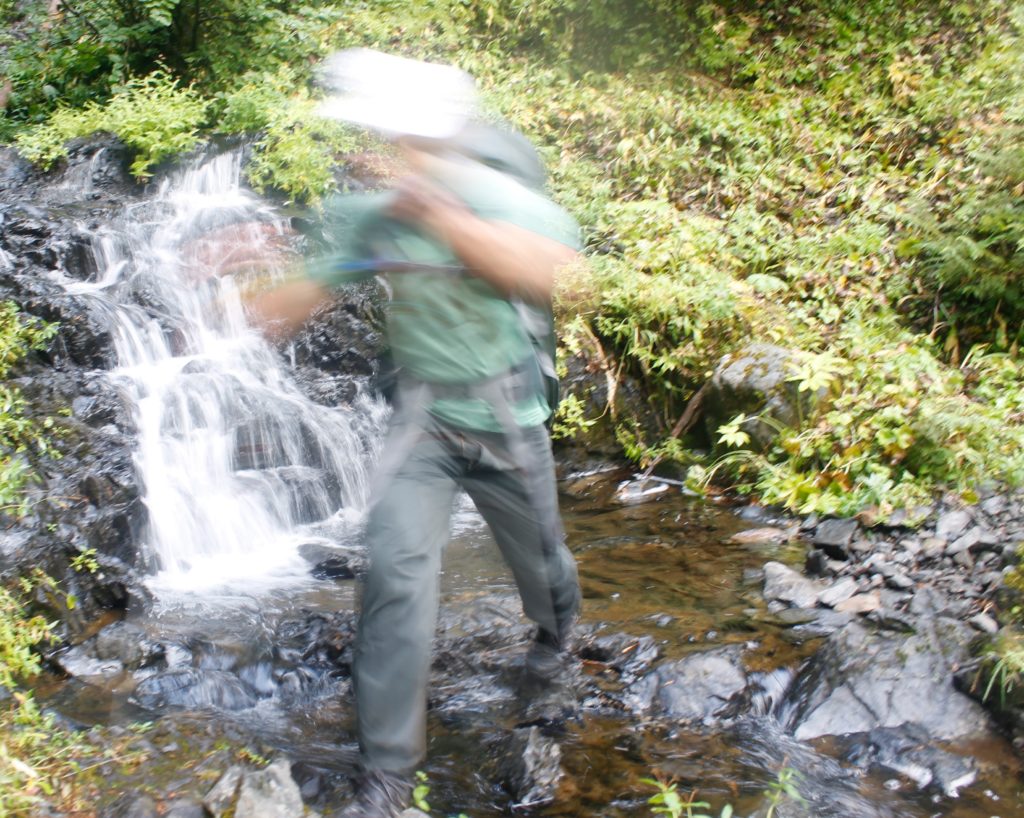
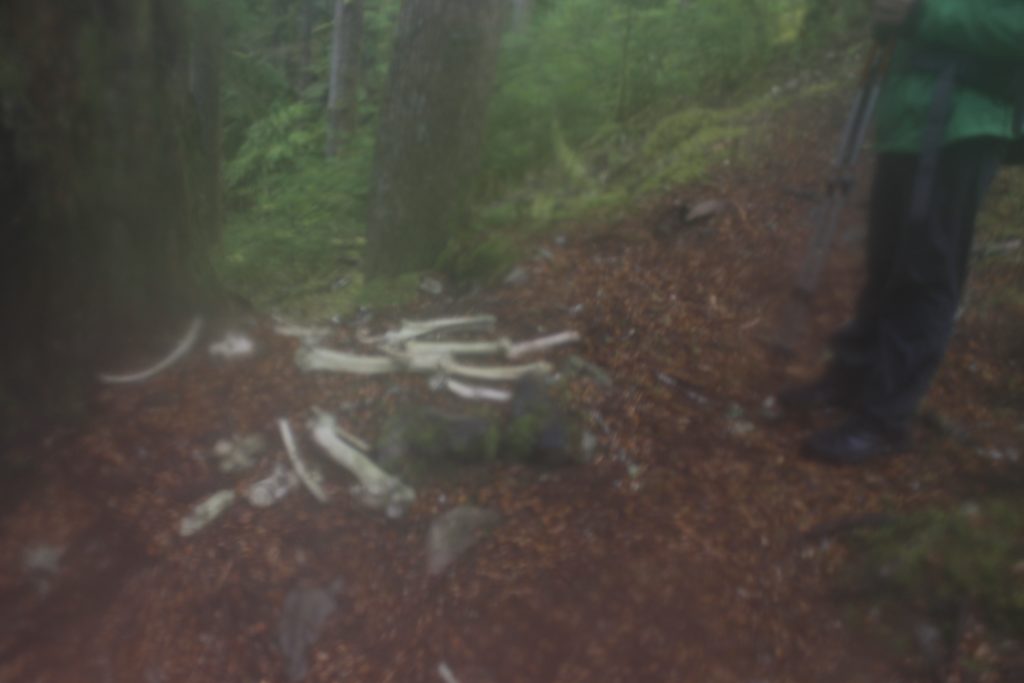
But the wonder of the Hoh Rainforest was worth even a brief visit. In contrast to the tundra we had seen earlier, life ran rampant here. Massive conifers towered over with their lower branches draped in goat’s beard. Thick moss ran up and down the trunks of maple trees. Gigantic fallen logs supported ecosystems of sword fern moss and smaller plants growing out of them.
The environment had that fairy tale feeling to it, so much so that I almost expected to run across some Keebler elves out gathering mushrooms.
Elves we did not find, but sometimes we would stop and gawk at one of the enormous banana slugs or the black slugs that crawled onto the path.
The moist air was warm, almost sultry, compared to the exposed heights where we had hiked earlier. A whopping 141 to 165 inches of rain fall in this rainforest.*
We took breaks to explore an incongruous meadow, then did lunch at an overlook above the Hoh River, which was low and milky-white with sediment.
Much of the river originates from glacial melt off Mount Olympus. If we were going to see any of this mountainous splendor, it wouldn’t be from here. A low cloud base above the forest prevented us from seeing much above the tree tops.
The climb back up was a long one, but fortunately, passing hikers had knocked most of the moisture off the branches along the trail and we didn’t get so wet as when we started.
We stopped back at Hoh Lake to skip some rocks. There were no bears that we could see, but there was an occasional fish jump.
When I went up to the bear cable to bring the food down, the clouds broke and afforded me a view of the glaciers of Mount Tom and Mount Olympus. Miles of ice sat in the depressions between jagged crags.
I called Sean up and we watched the mountains. Even though Olympus is not quite 8,000 feet tall, the sharp profile of the mountains could have passed them off as giants of the American Rockies. The fact that there were huge glaciers helped too. In fact, we were looking at the third largest glacial system in the continental U.S. ** Altitude isn’t everything, especially when considering the 50 to 70 feet of snow that Olympus receives every year. Constant cloud cover protects the snowfields from the heat of the sun. Unfortunately, like most other glaciers in the world, the glaciers around Olympus have been in retreat. ***
As the sun sank toward the western horizon, the glaciers glowed in the pinkish light. Many hikers never get to see Olympus because it is so often in the clouds. I was glad that we had this chance.
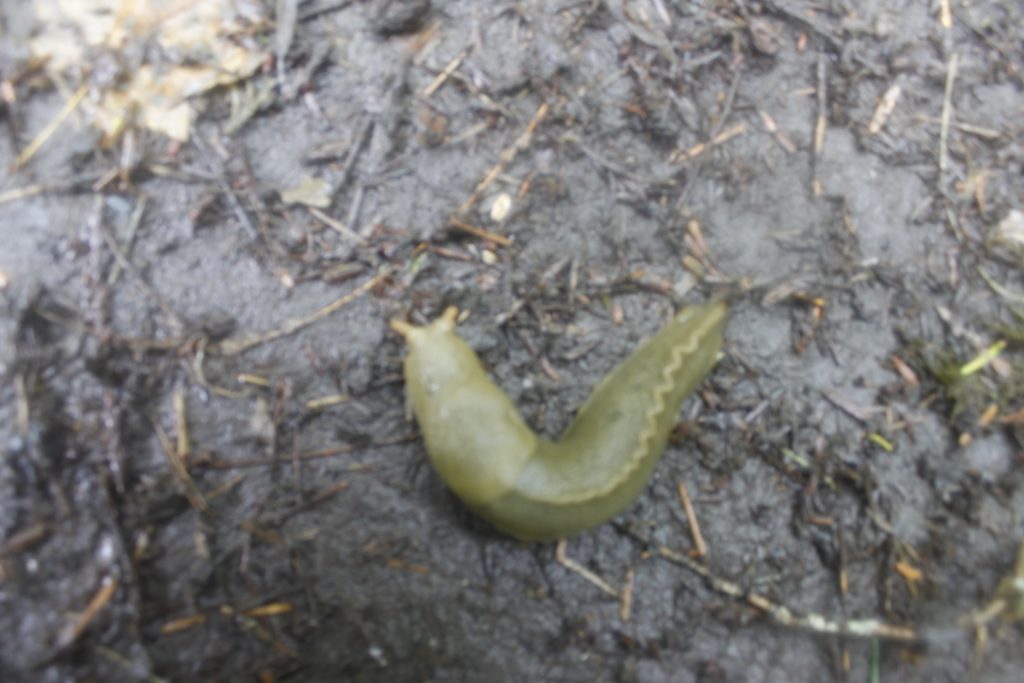
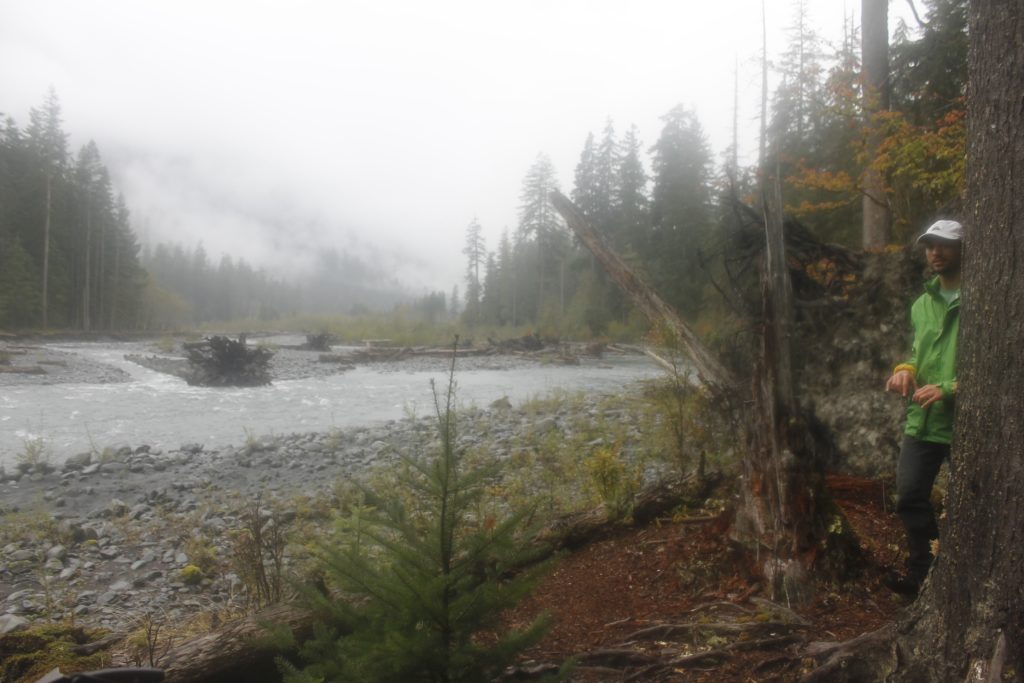
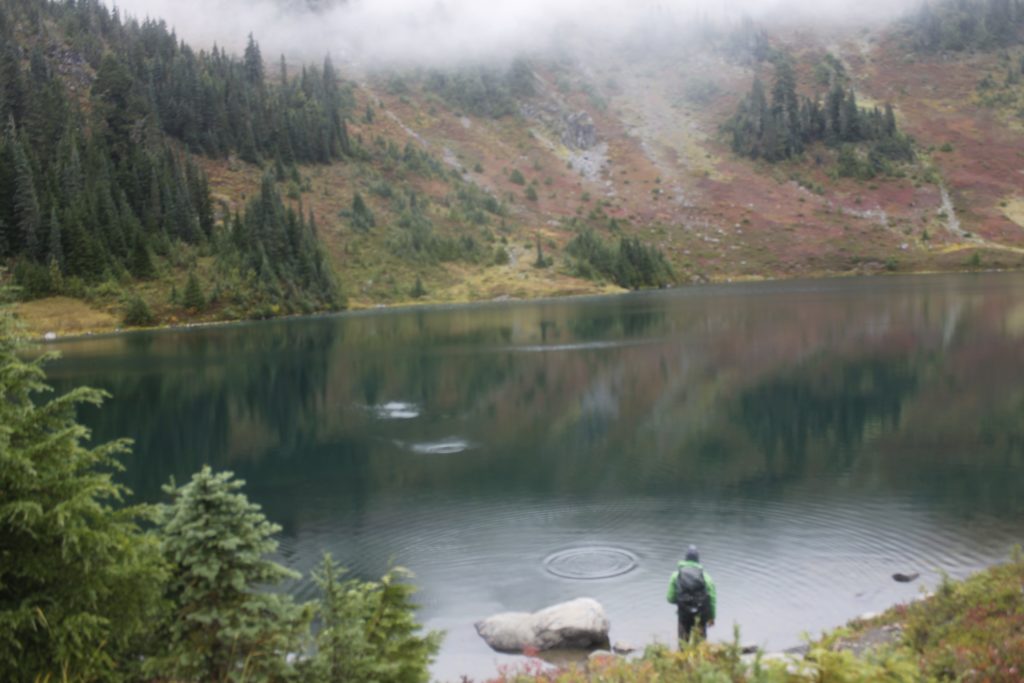
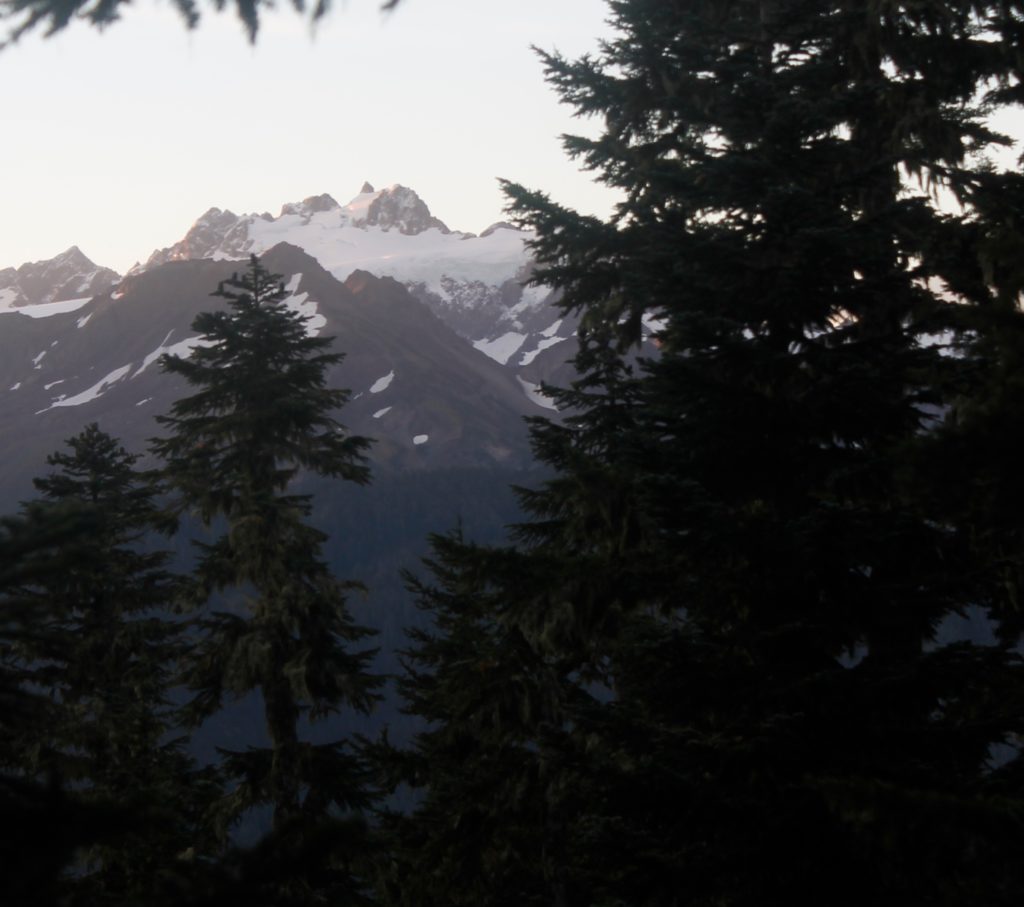
More Bears and Mountain Views.
Early the next morning we hiked out of camp with after a light oatmeal breakfast. We had cut things a little fine with our food planning, so most of our lunch calories were going to come from bars and gel.
The morning chill left us as we climbed back up toward Bogachiel and the sun began to emerge.
Going past the plains of blueberries, we saw two black bears. One was on the trail, the other below. They were about the same size as the bears we had seemed earlier, and it seemed likely that they were the same ones.
We decided to wait a few minutes to see if the bear on the trail would move. When it didn’t, we started shouting, and the bear moved, slowly, up the hill.
We decided to add some miles to our total going back by following the High Divide trail the rest of the way around the Seven Lakes Basin, before descending back to the Sol Duc river. This route turned out to be an excellent choice because we were lucky enough to have more clear weather. We had superb views of Mount Olympus and some of the other nearby Olympic peaks.
As we walked further east, we got a better look at the Blue Glacier. Deep cracks within the ice revealed where it got the name, displaying that sublime turquoise tint you might recognize from photographs of arctic icebergs. Further down, the glacier formed a long tongue through the mountain valley.
Tragically, my lens was fogged for much of the morning, and I didn’t get any good shots of the mountains from this angle.
The warm sun and clear skies lent itself to more huckleberry picking, so Sean and I stopped frequently to load up.
We saw two more bears on distant hillsides, enjoying the same snack. That brought the number of unique bear sightings up to at least six for our trip — doubling the number of bear sightings that either of us had seen in our lifetimes. But who’s counting?
The trail took us down along the Sol Duc, offering plenty of opportunities to enjoy the sight of waterfalls in the mossy canyon.
We were no longer contemplating the natural beauty in solitude however. Several groups of hikers coming up the trail the other way to get to the campsites they had reserved for the weekend. It would be a lot busier on the ridges on the days to come. I was glad that we had seen everything when we did.
As for an encounter with Sasquatch? He stumbled out of the woods to give me a high-five — right after my camera battery died.
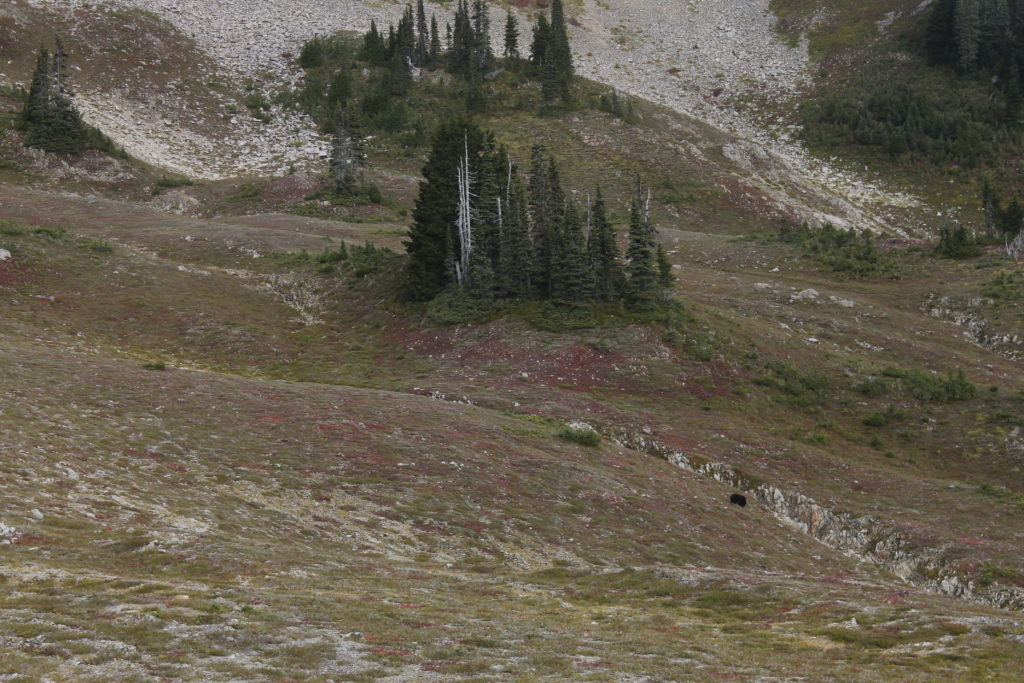
*http://www.summitpost.org/mount-olympus/150427
